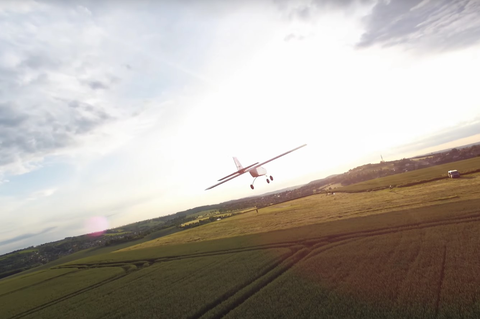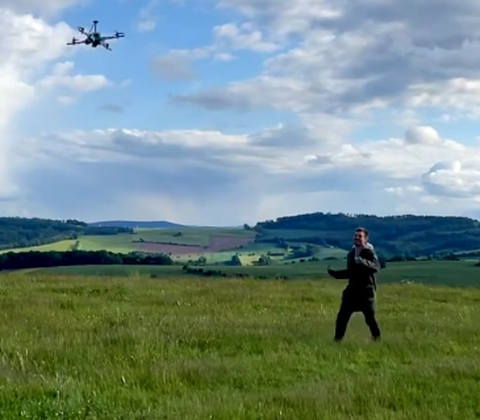Unmanned Aerial Vehicle
Unmanned aerial vehicles, also known as drones, include fixed-wing aircraft, multicopters and hybrid configurations. They have the potential for a variety of uses that go far beyond traditional aviation applications. These include, for example, the delivery of parcels, analysis of disaster areas, agricultural optimization and monitoring of nature reserves. The focus of current research is on
- the design and construction of application-specific drones
- the design of flight control systems and autopilots for safe and autonomous flight operations
- optimal flight route planning for energy efficiency or search grids
- the coordination and communication of several drones in a swarm.
Topics:
The Chair of Flight Mechanics and Flight Control currently offers the following topics for student research projects and theses. If you are interested, please get in touch with the contact person for the relevant topic. Please refrain from multiple requests.
The research company AEF - Autonom Elektrisch Fliegen gGmbH offers project work in the field of research and development for autonomous aviation technology, flight infrastructure & flight services (U-Space).
You can find more information and a brief introduction to the company here.
If you are interested in a promising programming job and flexible working hours, please contact AEF by phone and/or e-mail by November 30, 2025 .
Contact:
Florian Helm: +49 1577 400 19 44
Axel Schober: +49 176 471 340 24
Determining the most efficient flight path along a predefined route, for example damage evaluation of railroads, is significantly influenced by local wind an weather effects. Areas of upwind and downwind due to terrain changes need to be a available or predictable. These micro-scale wind components cannot be resolved by weather stations. Local measurement data from the area of operation in different weather conditions are required to accurately predict the meteorological data.
The aim of this work is to develop a flight measurement campaign for an example scenario at the UAS test site. During the test flights, data is collected from the aircraft-supported sensors for measuring the UAS movement itself as well as the external supported measuring systems, which use GPS, for example. The data is stored locally using the on-board computer and extracted after each flight. In a first step, the collected raw data must be processed using Matlab/Simulink, in order to handle outliers, incorrect or missing measured values. The data is then processed accordingly and features are extracted using signal processing. Combining the UAS data with the ground-based meteorological data enables a holistic analysis and comparison of the data as well as the optimization of the flight routes.
Contact person
 © Martin Guist
© Martin Guist
Research Assistant
NameDipl.-Ing. Martin Guist
Send encrypted email via the SecureMail portal (for TUD external users only).
Research about air cabs and delivery drones is currently focusing on determining the requirements for corresponding take-off and landing sites. Particularly in urban areas, the specific flight paths and take-off and landing options are subject to special influences. Due to their size, weight and electric propulsion, drones and air cabs are particularly susceptible to wind, gusts of wind, turbulence, precipitation, icing and extreme temperatures. At low altitudes they often operate in the meteorological boundary layer. That is the lowest part of the atmosphere, where the earth's surface and obstacles (e.g. buildings) generate strong turbulence. Weather sensitivity and weather hazards require novel, very precise flight planning and flight controllers based on a comprehensive weather situation picture of the lower airspace. The aim of this work is to develop approach and departure trajectories for drones to ensure safe operation.
Contact person
 © Martin Guist
© Martin Guist
Research Assistant
NameDipl.-Ing. Martin Guist
Send encrypted email via the SecureMail portal (for TUD external users only).
Drones are becoming increasingly popular in the field of disaster control and relief. In particular, the rapid operational readiness and danger minimization for pilots speak for these systems.
The aim of this work is the modeling of optimal flight routes in search and rescue scenarios. Accounting for wind and weather conditions as well as the causes of the disaster, for example forest fires, play a decisive role here.
Contact person
 © Martin Guist
© Martin Guist
Research Assistant
NameDipl.-Ing. Martin Guist
Send encrypted email via the SecureMail portal (for TUD external users only).

UrbanCondor X im Landeanflug
Motivation
The market for unmanned aerial systems has developed rapidly in recent years due to their wide range of applications. Fixed-wing aircraft in particular, which are capable of covering large distances, are used for searching extensive areas, supplying crisis zones or last-mile logistics. In terms of the maximum achievable flight distance, fixed-wing aircraft are generally superior to multicopters and VTOLs. However, autonomous landing poses a challenge when using unmanned fixed-wing aircraft. The aim of this thesis is to design an autopilot for landing the UrbanCondor X. The control system is designed on the basis of an existing flight dynamics model of the system. In order to ensure the safe execution of the landing approach, which is carried out at low speeds at low altitude, two aspects in particular are decisive in the design of the autopilot: the control system must be robust against model uncertainties and be able to react quickly to external disturbances such as gusts.
Task definition
- Literature research on current autopilot architectures for landing unmanned fixed-wing aircraft
- Define relevant model uncertainties and external disturbances
- Design of an autopilot for landing the UrbanCondor X (MATLAB)
- Evaluation of the capabilities of the autopilot using the in-house non-linear flight dynamics simulation in MATLAB Simulink
Contact person
 © Martin Guist
© Martin Guist
Research Assistant
NameDipl.-Ing. Martin Guist
Send encrypted email via the SecureMail portal (for TUD external users only).

Quadrocopter im Flug
Motivation
Autonomous flight capabilities are generally required for the effective use of unmanned aerial systems. In many cases, the design of the necessary control algorithms is based on a mathematical model. In the context of this work, a flight dynamics model of a quadrocopter is to be derived via a system identification campaign.
Task definition
- Literature research on the system identification of multicopters
- Design of a suitable mathematical model structure with the parameters to be identified
- Design and implementation of a flight test program on the Flight Management Unit (Pixhawk 6x)
- Carrying out the flight tests
- Identification of the model parameters based on the flight test data
Contact person
 © Martin Guist
© Martin Guist
Research Assistant
NameDipl.-Ing. Martin Guist
Send encrypted email via the SecureMail portal (for TUD external users only).
If you are still unsure about your topic, we are also happy to offer general advice. Alternative options can also be presented based on the student's individual interests. We are also happy to support student theses with industry partners or initiative topic suggestions from students. The contact person for projects about unmanned aerial vehicles is:
 © Martin Guist
© Martin Guist
Research Assistant
NameDipl.-Ing. Martin Guist
Send encrypted email via the SecureMail portal (for TUD external users only).
